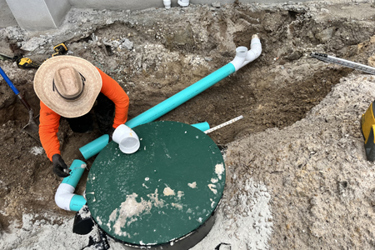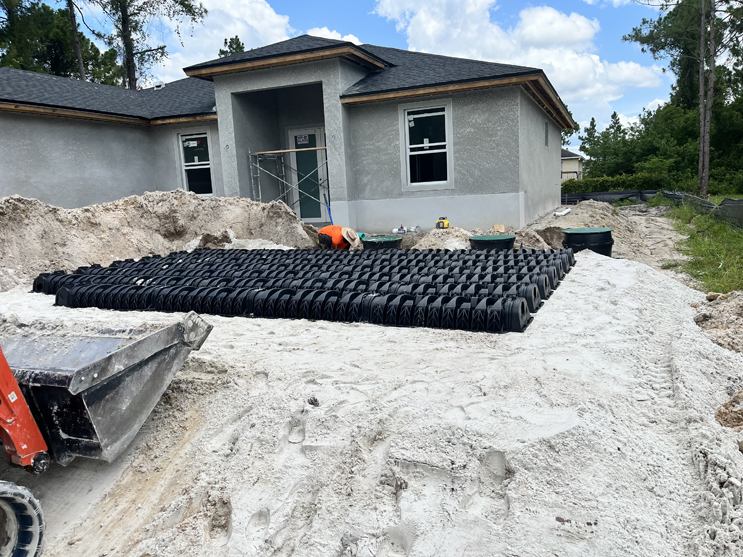Advances In Wastewater Treatment Systems To Address Limited Space And Stringent Regulations
By Joseph Fayan

The demand for smaller, highly effective wastewater treatment systems continues to grow due to land scarcity and high prices in many parts of the country and the desire by developers, builders, and homeowners to maximize the use of every square foot of property. This provides an exceptional challenge for critical infrastructure, including wastewater treatment systems, and has increased the demand for greater performance of these systems in a smaller footprint.
Performance is a key element of the discussion because as space allocation for infrastructure is being reduced, more stringent onsite wastewater system regulations are challenging manufacturers and system designers to increase performance. This has spurred a host of advanced solutions that can perform in commercial and residential applications and small footprints.
In coastal areas of the country like Florida, The Chesapeake, Long Island, NY, and Cape Cod, MA, protection of coastal waters and drinking water sources are becoming a focus for regulators. The good news is that options for residential onsite wastewater systems that can provide this protection have grown as manufacturers rise to the challenge.
Special Considerations For Smaller Wastewater Treatment Systems
While smaller can be better, there are several considerations that system designers need to consider when designing these systems.
- The need to settle out solids.
Drainfields alone are not capable of handling solids regardless of treatment level targets. Sufficient design parameters must be in place to remove solids in the treatment tank to avoid clogging or overloading a drainfield. - The need to achieve desired treatment levels.
As populations boom, the cost of land increases and lots become smaller. Moving nature’s biological treatment into a treatment unit helps to ensure the water we rely on is safe. Advanced wastewater treatment units like the ECOPOD-Edge provide an average nitrogen reduction of greater than 79% ensuring cleaner water being returned to groundwater supply through discharge from the treatment unit to the drainfield. - The need to allow for proper O&M.
Treatment units, like all highly performing machines, need to be properly maintained to avoid performance issues that would hurt their ability to achieve design targets. Pumps, aerators, and electrical components all require maintenance along with the requirement to check the unit for solids and pump when needed. These units are designed with mechanical components and require maintenance to function properly. Most homeowners contract with licensed service providers to routinely inspect the system and provide repairs as necessary.
Residential Advances For Smaller, Highly Efficient Wastewater Treatment
System sizes have progressively been getting smaller to help meet the demands of growing communities, particularly in coastal areas. Small lots, large houses, pools, verandas, and other landscape elements leave little room for the necessary infrastructure required to protect the environment. Builders look for solutions that fit, and smaller is considered better. Consider that many vacation homes near the water are on particularly small lots.
While the space available for these units has decreased, the treatment expectations simultaneously increase putting strains on designs. Many states like Florida, Massachusetts, New York (specifically Long Island), and Virginia have implemented higher treatment level requirements, particularly around nitrogen removal. The increased performance required on smaller sites forces designers and installers to truly make use of every cubic inch of the treatment unit to perform all the steps necessary to achieve the desired targets. In the past, an advanced treatment unit may have required an installation consisting of two or more tanks. Now, these systems are being designed for installation in a single tank and can perform well when space is a challenge.
Are advanced treatment systems the answer to the competing objectives of higher treatment in a smaller space? Biology restricts the amount of treatment that can occur in traditional passive septic tanks. Highly engineered solutions provide the environments required to allow natural processes to occur before the effluent discharges to the soil. This acceleration of treatment can only be achieved through advanced treatment solutions.
While municipal systems typically have dedicated personnel for operation and maintenance, in residential applications the homeowner is often relied on as the first line of defense. Homeowners can do critical things to ensure proper operation, including ensuring only items that should go down the drain do. They can also periodically monitor the system to look for indications of issues such as odors emanating from the system to checking system visual and audio alarms that typically exist. Just as important is that homeowners have contracts with maintenance providers who are experts for scheduled professional preventative maintenance and who can perform any more intensive work needed. Manufacturers also have stepped up to design and manufacture highly reliable systems that have minimal maintenance requirements and less risk to the environment.
One example of a new type of system that not only reduces total nitrogen (TN) by 79% but is designed for exceptional treatment in a small footprint is a fixed-film advanced gravity flow wastewater treatment system called the ECOPOD-Edge. Engineered to deliver stable, robust treatment under continuous or intermittent use, the system also operates with minimal maintenance and produces superior effluent quality achieving 9 mg/L CBOD5 (five-day carbonaceous biochemical oxygen demand), 8 mg/L total suspended solids (TSS), and 11 mg/L TN (79% reduction). The use of anoxic subzones within the aerobic chamber supports continuous biological nutrient removal. Installations in Florida have performed effectively and will surely lead to the development of additional similar products for sites with limited space and design constraints.

Low-profile chambers installed as part of a fixed-film advanced gravity flow residential wastewater treatment system
Advanced And Alternative Treatment Approaches In Action
Regulatory Changes in Florida Catalyze the Need for Total Nitrogen Reduction
Recent updates to Florida’s Basin Management Action Plans (BMAPs), released in June 2025 by the Florida Department of Environmental Protection (DEP), reflect a strengthened commitment to reducing nutrient pollution under the Clean Waterways Act. These revised BMAPs establish more rigorous nitrogen-reduction targets across multiple watersheds, including the North Indian River Lagoon, Lake Okeechobee, and the Caloosahatchee and St. Lucie estuaries. As part of this initiative, the legislation now places increased emphasis on upgrading residential wastewater systems to incorporate high-performing advanced treatment technologies capable of reducing TN influent by as much as 65%. The result is a growing demand for innovative, reliable nitrogen-removal solutions that can meet both environmental goals and regulatory compliance and can fit on small lots typical of Florida developments.
This has challenged homeowners to find the resources to pay for the required system upgrades. System installers are working with homeowners to provide cost-effective solutions that will meet the new requirements and manufacturers are working to develop products to meet these needs.
Massachusetts Title 5 Regulations Reshape Residential Treatment
Recent updates to Massachusetts Title 5 regulations are reshaping residential wastewater treatment on Cape Cod, with a sharp focus on reducing TN discharge to protect fragile coastal ecosystems. Homeowners in designated nitrogen-sensitive areas must upgrade their septic systems to innovative/alternative (I/A) technologies within five years unless their municipality secures a watershed permit. These advanced systems are designed to significantly lower nitrogen output, but manufacturers face mounting challenges in meeting the stringent performance standards — especially given the compact lot sizes typical of Cape Cod’s residential neighborhoods. The limited space complicates installation onto existing properties while trying to limit the impact to the homeowner’s yard. Varying technologies, from standard aerated solutions all the way to those relying on woodchips, have emerged to meet the treatment levels while trying to minimize the impact on homeowners.
Conclusion
As treatment level requirements are increasing and residential lots are becoming smaller, space dedicated to onsite wastewater systems is decreasing. These two opposing constraints are driving wastewater treatment system manufacturers and designers to develop new approaches that excel with small footprint treatment levels.
To keep pace, these companies are allocating a higher percentage of their research dollars to treatment strategies that meet the environmental and market demand. More than ever, they are hiring PhDs, biologists, and environmental engineers to apply their knowledge to wastewater treatment design advances. The knowledge and application of how the biology works is key to maximizing the use of space in a treatment and underpins all the current product design innovation.
The advanced fixed-film gravity flow system mentioned is only one example of the exciting developments that are coming out of these efforts. The benefits of this work are far-reaching for residential and commercial systems with the biggest beneficiary being public health and the environment.
Joseph Fayan is Director of Product Management at Infiltrator Water Technologies. He has been with Infiltrator for 10 years and has over 30 years of experience in design engineering and product management. Joe started his career designing and building our country’s nuclear submarines and is now committed to helping to protect the environment by improving water quality. He holds a BS in Mechanical Engineering from the University of Rhode Island and a MS in Management Technology from Rensselaer Polytechnic University. jfayan@infiltratorwater.com
